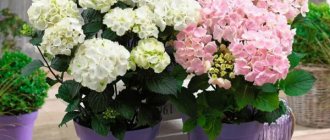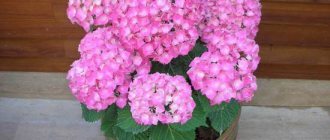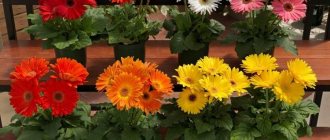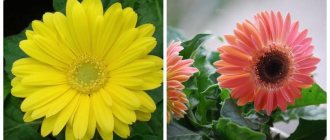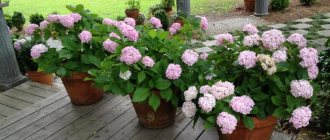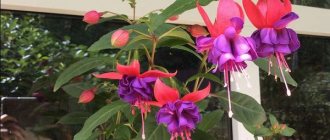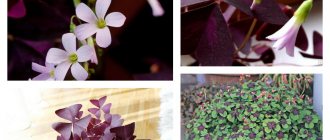Author: Elena N. https://floristics.info/ru/index.php?option=com_contact&view=contact&id=19 Category: Houseplants Published: January 24, 2019Last edits: January 11, 2021
- Cuttings
- Hydrangea turns yellow
plant (lat. Hydrangea) belongs to the genus of flowering plants of the Hydrangeaceae family, numbering about eighty species, among which there are small trees and shrubs. In the wild, hydrangea grows in both Americas, as well as in China, Japan and other countries in East and South Asia. The plant was named in honor of a certain princess of the Holy Roman Empire, whom no one remembers, and the name “hydrangea ,” which translated from ancient Greek means “vessel of water,” was given to hydrangea by systematic botanists for its exorbitant love of moisture. In Europe in 1820, the plant appeared as a house hydrangea, and only later it began to be grown in gardens. Since the hydrangea bush settled in our homes, breeders have not stopped their experiments in developing new varieties and varieties. Today, hydrangea in a pot on a veranda, terrace or balcony is as common as hydrangea in the garden.
Planting and caring for hydrangea
- Flowering: from April to November.
- Lighting: bright diffused light (at a distance of 2-3 meters from the south window).
- Temperature: during the growing season – 20 ˚C, during the dormant period – 7-10 ˚C.
- Watering: in summer - frequent and abundant, in spring and autumn - moderate and not so frequent, during the dormant period - symbolic.
- Humidity: high; in hot weather, frequent spraying of leaves is recommended.
- Feeding: from February to October once every two weeks with complex mineral fertilizers for flowering plants - rhododendrons, heathers and azaleas. In winter, no fertilizing is applied.
- Dormant period: December-January.
- Transplantation: annually throughout the life of indoor hydrangea (3-4 years).
- Pruning: in the fall after flowering, weak shoots are removed and strong ones are shortened by half their length, and in the spring, weak shoots that have stretched out during the dormant period are removed.
- Reproduction: seeds, cuttings, dividing the bush.
- Pests: aphids and spider mites.
- Diseases: gray rot, peronosporosis.
Read more about growing hydrangeas below.
Temperature
Indoor hydrangea lives up to its name, feeling comfortable at normal temperatures in the apartment (provided there is fresh air). In cold weather, in order to stimulate flowering in the spring, it would be useful for hydrangeas to create conditions reminiscent of the wintering of its garden relatives.
To do this, the pot is placed in a very cool room (basement, glassed-in balcony, veranda, etc.). In this case, watering should be greatly reduced, but not completely canceled: do not forget about the love of hydrangea for water.
Botanical description
Indoor hydrangea is a perennial subshrub with opposite, large, toothed, ovoid leaves 10 to 15 cm in length. The inflorescences-balls are also large - up to 35 cm in diameter, umbellate, corymbose or in the shape of a brush, consisting of two types of flowers: large sterile ones at the edges of the inflorescence and small fertile ones in the middle. The color of the inflorescences depends on the pH value of the soil: acidic soil gives them a blue tint, neutral - white or cream, and alkaline - lilac or pink, and the flower petals are colorless, and the brightly colored sepals of the flowers give the inflorescences tint and decorativeness. The fruit of hydrangea is a multi-seeded capsule. At home, hydrangea can reach a height of one meter.
Caring for hydrangea at home
Growing conditions
Hydrangea at home has the same preferences as its garden relative, and if you create the necessary conditions for it, you will be rewarded with long and lush flowering. Find a spacious, bright place for the hydrangea, protected from scorching sunlight - two to three meters from a south window, for example. The most comfortable temperature for its growth and development is 20 ºC, absence of drafts and sudden temperature changes.
During the dormant period that comes after flowering, place the plant in a dark, cool room with a temperature of 7-10 ºC and keep it there until the buds begin to wake up in February, and then return it to its usual conditions. The plant needs a cold, dark winter to restore the energy spent on flowering, and if this requirement is not met, the next hydrangea flowering may occur only in a year.
- Photos of alocasia species
Watering
But first of all, caring for home hydrangea involves regular and sufficient watering, which can fill this “water vessel”. In summer, watering should be frequent and abundant, in spring and autumn - moderate, in winter, during the dormant period - symbolic. Water for irrigation is settled, filtered or frozen, and then thawed to room temperature. If you live in an ecologically clean area, then rainwater will also be good.
Once a month, water the plant with slightly acidified lemon water - literally five drops of juice per liter of water. Hydrangea requires not only moist soil, but also high air humidity, so be prepared to spray it often and do not place it near operating heating devices.
Fertilizer
Growing hydrangea also involves feeding the plant during the period of active growth. Fertilizers for hydrangeas are applied once every two weeks. Complex fertilizers are suitable as fertilizing for flowering plants - azaleas, rhododendrons and heathers. They begin to feed hydrangea in February, when the plant forms new shoots. In winter, during the rest period, hydrangea does not need feeding.
By the way, in order to get a multi-colored bush in one pot, you just need to add a solution of ammonia-potassium alum (8-10 alum per 2 liters of water) or iron salts to the soil on one side of the pot, then the inflorescences on this side will turn blue, on the other hand, you can add lime to the soil, and the inflorescences will turn pink or lilac. As a rule, white or cream hydrangeas grow on neutral soil.
Pruning indoor hydrangea
Caring for indoor hydrangea includes such an important element as pruning the plant. Readers ask how to prune hydrangeas and whether it should be done if the hydrangea is growing at home and not in the garden. Domestic hydrangeas need to be pruned, and this is done twice a year: in the fall, after flowering, preparing the plant for winter rest, weak shoots are removed at the root, and strong shoots are shortened by half their length, and pruning of hydrangea in the spring is needed to remove weak shoots that are too elongated.
Transfer
Caring for hydrangea in a pot involves annual replanting - as a houseplant, hydrangea lives for 3-4 years, then you need to plant a new one. Hydrangea soil requires fertile soil, approximately the following composition: three parts each of leaf and turf soil and one part sand. Choose a spacious and wide pot, since the root system of hydrangea is horizontal. How to replant hydrangea to minimize the stress for the plant that usually accompanies this procedure? Transshipment method. And don't forget to place a thick layer of drainage material at the bottom of the pot.
- How to choose the right pear seedling, when and where it is better to plant so that it takes root
After you move the plant from the old pot to the new one, add enough fresh substrate to it so that it fills all the voids, but the root collar of the plant should be flush with the surface of the soil. After planting and moistening the plant, it is advisable to cover the soil in the pot with peat mulch, which will not allow moisture to quickly evaporate from the substrate.
Is it possible to change the color?
Changing the color of home hydrangea is a separate fascinating topic. In some cases, the color of the petals depends on the composition of the soil, so if you want to get blue flowers, the soil can be enriched with iron salts (simply adding iron filings or ordinary nails to a pot of soil).
Note! Another option is to spray the hydrangea with a solution of potassium alum: 7-8 g per 1 liter of water. This should be done twice a week. Then the pink flowers will turn blue, the dark pink ones will become violet-blue, and the red ones will become pure purple.
Propagation of hydrangea at home
Cuttings
If you ask a professional gardener how to propagate hydrangea at home, he will tell you that the most reliable method of propagation for hydrangea is cuttings, and the best time for this is January-February. Cuttings rooted at this time will form a multi-stemmed bush of 3-4 shoots by next autumn. If you are late with cuttings and carry it out in March-April, you will get a single-stem plant.
It is better to cut cuttings from root shoots so that there are up to three internodes on a segment 7-8 cm long. The leaves from the bottom of the cuttings are removed, and the top ones are shortened by a third if they are small, or by half if the leaves are large. The cuttings treated along the lower cut with a root stimulator are planted in a peat-sand substrate and kept in the light at a temperature of 18-20 ºC and an air humidity of 75-80%, for which the cuttings are covered with glass jars, which must be removed daily for ventilation.
Do not forget to moisten the soil - it should not dry out. Rooting occurs in three to four weeks, then the cuttings are planted in individual pots with a diameter of 7-9 cm.
Growing from seeds
If you don't know how to grow hydrangea from seeds, the following information will be helpful. The soil for sowing seeds should consist of leaf, turf soil and humus in equal parts, but half of sand and peat should be added to them. At the end of winter, small hydrangea seeds are sown in a bowl on the surface of the substrate, but they are not planted in the soil, but are covered with glass.
The crops are ventilated daily and, if necessary, moistened with a sprayer - the soil should be slightly moist at all times. As soon as the shoots appear, the glass is removed, and when two true leaves appear, the seedlings dive into deeper containers with soil of the same composition. Strengthened hydrangea seedlings are planted in pots with a diameter of 7 cm.
Dividing the bush
This is the easiest way to propagate hydrangeas, but it requires some dexterity and great care. When replanting the plant annually, divide the bush so that all divisions have growing points and a sufficient number of roots. Both the roots and shoots of the divisions are shortened before planting, then the parts of the plant are planted in different pots, watered and the surface of the soil in the pots is mulched with peat. If you divide the bush in the spring, then by autumn your divisions will already be well rooted.
- Hamedorrhea at home
Pests and diseases of hydrangea
If the humidity is too high, hydrangea is affected by gray rot, which can be dealt with by treating the plant with Bordeaux mixture, and downy mildew, which is destroyed by copper-containing preparations or fungicides. If there is insufficient moisture, hydrangeas are harmed by spider mites and aphids, which are destroyed by double treating the plant with a soap solution or actellik at weekly intervals.
Hydrangea turns yellow
Most often, the cause of discoloration of hydrangea leaves is a violation of the rules of care - insufficient watering of the plant, lack of nitrogen in the soil, or a disease such as chlorosis, which occurs due to the fact that the soil in the pot is too alkaline. Correct your mistakes and the plant will get better.
Hydrangea is drying
Sometimes this happens simply because you forget to water and spray it, sometimes because of a lack of nutrients in the soil or because the roots of the plant were injured during an awkward transplant, that is, in any case, due to a violation you rules for caring for a flower. Change your attitude to the rules: if you strictly follow them, which in itself is not difficult, you will not have problems with either hydrangea or any other plant.
Hydrangea falls
As a rule, falling is the next stage after the leaves dry out. The plant needs not just abundant watering, but regular moistening of both the soil and the air, so water the soil and spray the hydrangea leaves as the need arises.
Hydrangea doesn't bloom
This can happen if the hydrangea did not rest in winter - it used up its energy on flowering, and it was not possible for it to accumulate new ones on the windowsill near the hot radiator, and this is not its fault. She needs complete rest for 70-80 days in a cold, dark room, even if she does not look like an exhausted plant - the leaves have not fallen or dried out. Find a room or basement suitable for the dormant period, remove all the leaves, shorten the strong shoots by half, cut off the weak shoots at the root, take the pot with the plant to a suitable room and lay it on its side. This needs to be done in December, so that in February you can bring the hydrangea back to life. By observing this ritual annually, you can be sure that the hydrangea will definitely bloom in due time.
Humidity
Hydrangea can easily tolerate normal humidity in an apartment, but will be grateful to you for periodically washing the leaves in the shower to remove dust. The leaves can also be wiped with a damp cloth.
If the flower is located close to a working battery, it is good to spray the leaves. In spring and summer, you can spray hydrangea as desired, not too often.
- Important: spray the leaves, not the flowers, and use settled water.
Types of home hydrangea
large-leaved hydrangea (Hydrangea macrophylla) , or garden hydrangea, and its numerous varieties, of which there are already more than 100 today, are grown in pots
Varieties of white and cream-colored inflorescences:
- M-me E. Mouillere - the diameter of the inflorescences is 18-20 cm, the flowers are from 2 to 6 cm, the leaves of this hydrangea are somewhat narrower than those of other varieties;
- Souer Tharese - flowers of regular shape, inflorescence diameter 15-17 cm, the bush itself is short - 35-40 cm, early flowering variety.
Pink varieties:
- Goliath - large inflorescences of a deep pink hue with a diameter of up to 30 cm, the edges of the sepals are deeply cut, the bush is 60-70 cm high, blooms late;
- Hamburg - compact flowers 4-5 cm in diameter, pink, collected in an inflorescence with a diameter of 16-18 cm, bush height 35-40 cm;
- Europe - a profusely flowering variety 40-50 cm tall with large flowers up to 6 cm in diameter, the inflorescence is 20-25 cm across.
Red varieties:
- Red sensation - burgundy-red inflorescences that become violet-burgundy when iron salts or aluminum sulfate are added to the soil;
- Prima - the diameter of the inflorescences is 15-18 cm, but the flowers themselves are small - no more than 3.5 cm in diameter, the stem height is 20-25 cm, a medium-flowering variety.
Blue varieties:
- Early Blue - bright blue inflorescences, tall variety;
- Ramars Mars is a compact variety, inflorescences up to 20 cm in diameter, over time the ends of the petals turn green.
